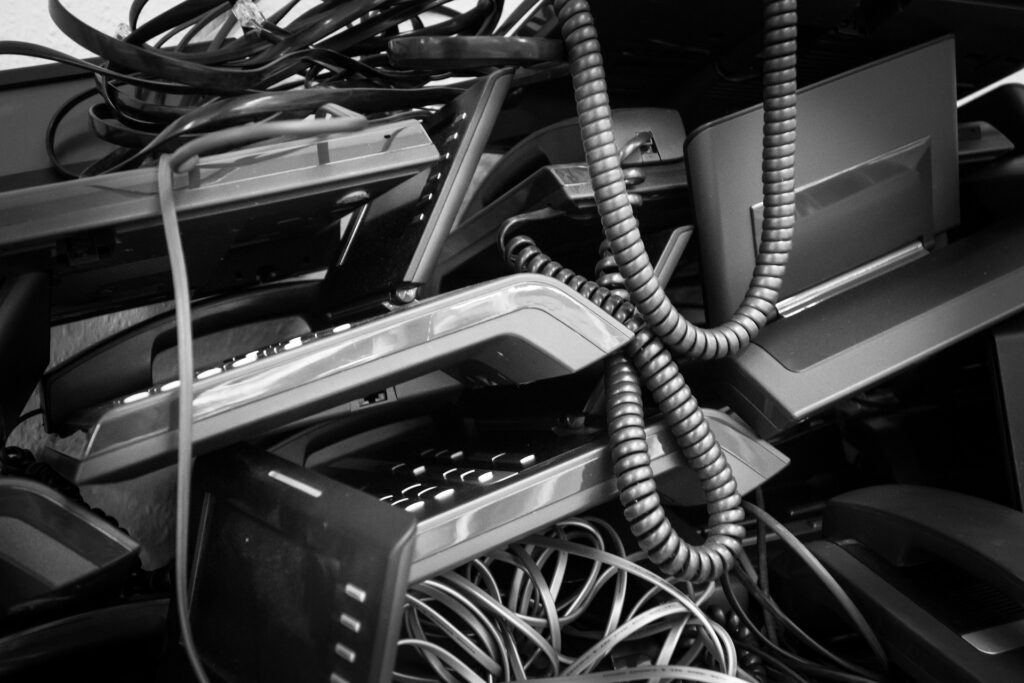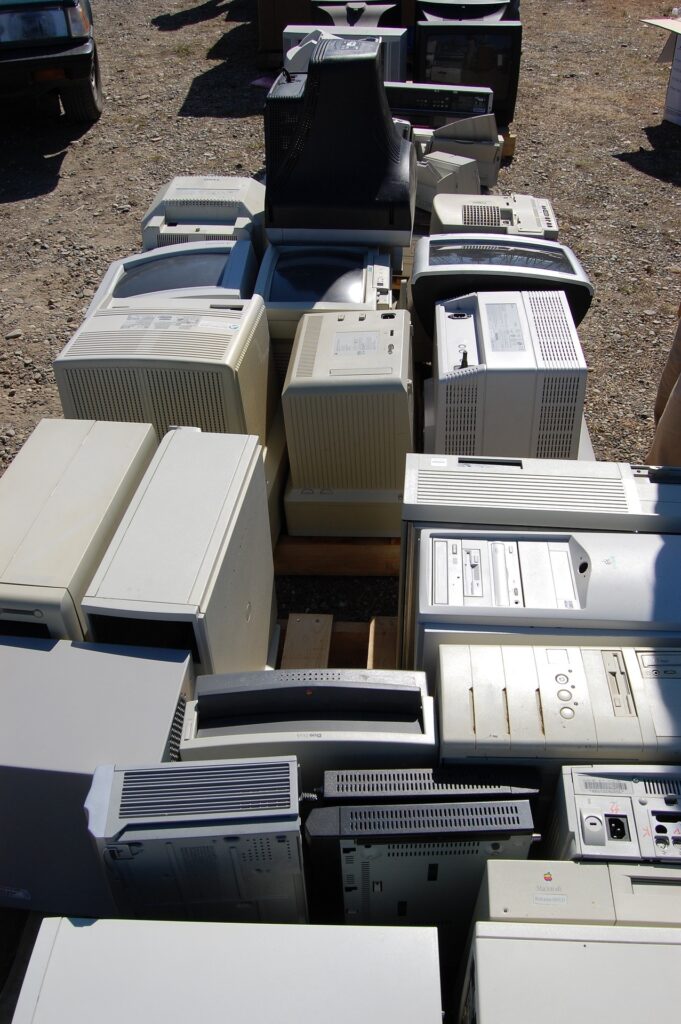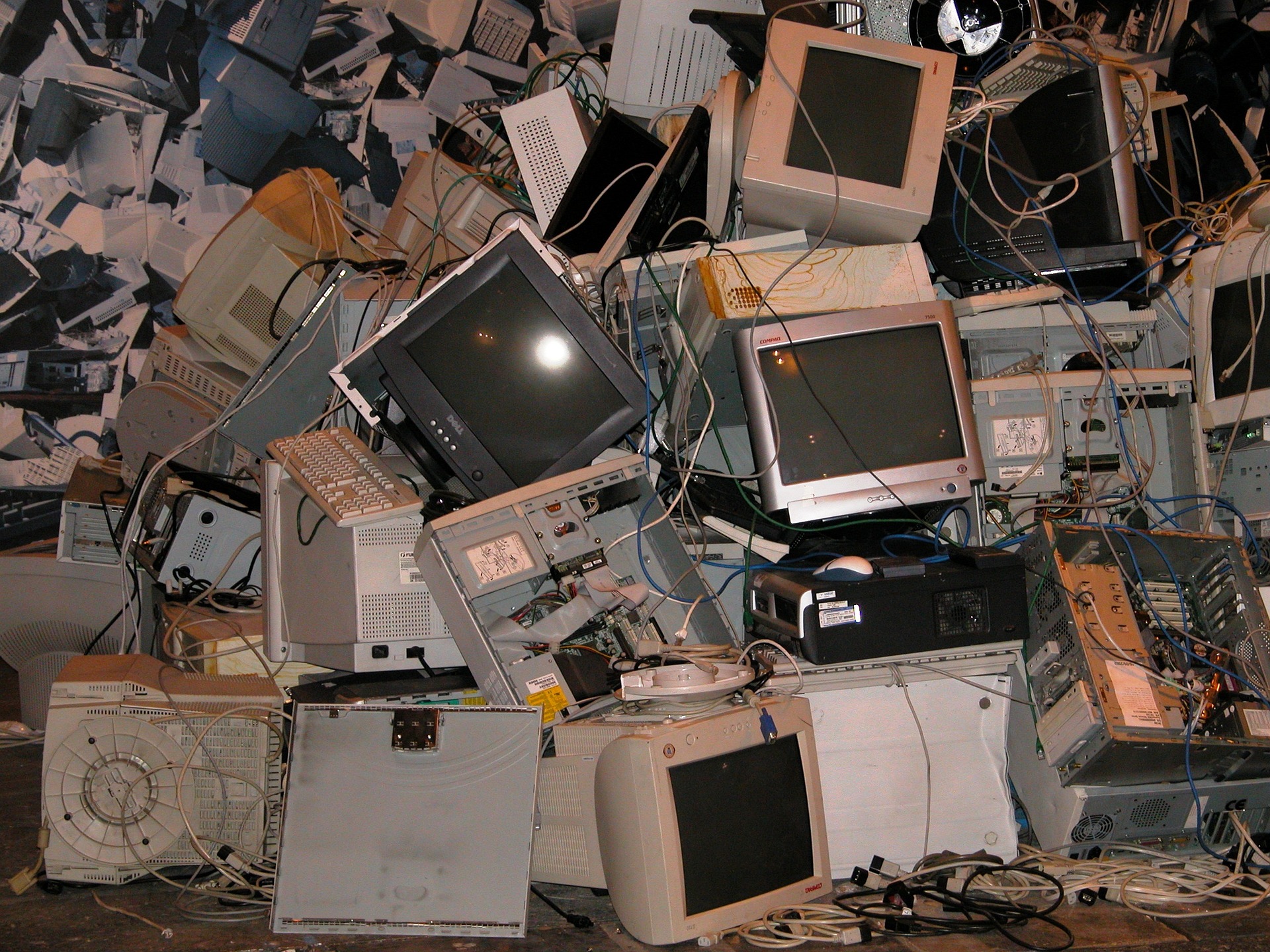In our fast-paced, gadget-driven world, electronic devices have seamlessly integrated into our daily lives, transforming how we communicate, work, and entertain ourselves. The digital age has gifted us convenience, efficiency, and connectivity like never before. Yet, with every upgrade, every new device that promises to make our lives easier, we inadvertently contribute to a growing dilemma – the escalating growth of electronic waste, or e-waste.
Introduction
Picture this: the smartphone in your hand, the laptop on your desk, even the toaster in your kitchen – they all have a lifespan. But what happens when their time is up? Many of these electronic companions meet a fate that’s far from environmentally friendly. They join the ranks of e-waste – discarded electronics that pose a mounting challenge to our planet and its inhabitants.
In the coming sections, we’re about to dive headfirst into the labyrinth of e-waste, dissecting its implications, uncovering strategies for responsible disposal, and even sharing a humorous anecdote that shines a light on our intricate relationship with technology.
Importance of the Topic: Unmasking the Hidden Perils of Electronic Waste
In the digital symphony of our lives, electronic devices orchestrate convenience and connection. Yet, beneath this harmonious exterior lies a discordant truth: the grave consequences of electronic waste. This topic holds the key to understanding the intricate relationship between our tech-savvy society and the environment. By shedding light on the toxic materials, ecological damage, and health risks associated with electronic waste, we gain the power to make informed choices. The urgency to address this issue grows as mountains of discarded gadgets mount, emphasizing the vital need for sustainable solutions and responsible consumption.
Arousing Curiosity about Electronic Waste: Unveiling the Digital Dilemma
Imagine a future where discarded smartphones paint landscapes and old laptops serve as street signs. This isn’t a scene from a sci-fi movie, but a glimpse of our potential reality if the electronic waste epidemic isn’t addressed. The intrigue lies in the paradox – our beloved gadgets, designed to enhance our lives, often end up as environmental hazards. Delving into the world of electronic waste reveals a tale of precious metals, hazardous chemicals, and untapped potential. From the shadows of our technology-driven lives emerges a call to action, sparking curiosity about the hidden journey of our electronic companions.
Understanding Electronic Waste
Electronic waste, often referred to as e-waste, encompasses discarded electronic devices ranging from cell phones and televisions to refrigerators and washing machines. As our world becomes increasingly digital, the lifespan of our gadgets shortens, leading to a rapid turnover of devices. The allure of new features and improved performance prompts us to upgrade, but have you ever wondered where our outdated devices end up?
Defining Electronic Waste (E-Waste): Unmasking the Digital Discards
Electronic waste, often abbreviated as e-waste, encompasses the discarded remnants of our technological pursuits. It refers to any electronic device that has outlived its utility or relevance, destined for disposal. This could range from obsolete cell phones and worn-out laptops to defunct refrigerators and obsolete game consoles. E-waste is a complex blend of modern convenience and environmental challenge, demanding our attention to navigate its intricacies and find sustainable avenues for its management.
Types of Electronic Devices Contributing to E-Waste: From Gadgetry to Cast-offs
Our insatiable hunger for innovation comes at a cost – a mounting pile of electronic cast-offs. A myriad of electronic devices, each with its specific lifespan and purpose, contribute to the e-waste deluge. Smartphones, tablets, laptops, televisions, kitchen appliances, and even fitness trackers – all contribute to the electronic waste stream. Whether it’s the latest upgrade trend or the pursuit of novelty, these once-cherished devices eventually join the ranks of e-waste, awaiting their fate in the labyrinth of disposal options.

Electronic Waste: The Alarming Growth
Prepare to be astounded by a sobering statistic: it’s estimated that over 50 million tons of electronic waste are generated worldwide each year, equivalent to about 1,000 laptops being discarded every second. This surge is fueled by our insatiable appetite for the latest gadgets, coupled with planned obsolescence – a strategy where manufacturers design products with a limited lifespan to encourage frequent replacements. As a result, landfills and incinerators are clogged with electronic cast-offs, releasing harmful chemicals into the environment.
Statistics on the Increasing Volume of Electronic Waste: Unveiling the Alarming Numbers
The digital age, with its rapid technological advancements, has birthed an unintended consequence: a colossal surge in electronic waste. The numbers are staggering – each passing year witnesses the birth of more than 50 million tons of electronic waste globally. To put it in perspective, that’s a thousand laptops discarded every second. As our fascination with novel gadgets drives us to embrace the latest trends, we unknowingly contribute to this escalating predicament. The sheer scale of this issue beckons us to explore sustainable solutions that curtail this influx of electronic waste.
Factors Driving the Surge in Electronic Waste: The Tangle of Innovation and Consumption
The propulsion of technology into every facet of our lives has a bittersweet consequence – the proliferation of electronic waste. Rapid product lifecycles, driven by incessant innovations, urge consumers to chase the next upgraded version, rendering their current devices obsolete. This culture of constant consumption, coupled with planned obsolescence by manufacturers, fuels the e-waste epidemic. The amalgamation of changing trends, desire for the newest features, and the temptation of trendy gadgets intertwines to create a tangled web of electronic waste. This surge is a testament to both human ingenuity and the need for conscientious consumption practices.
Environmental Impact: The Hidden Dangers
Unbeknownst to many, electronic devices harbor a toxic concoction of materials – lead, mercury, cadmium, and more. When e-waste ends up in landfills or is improperly processed, these hazardous substances can seep into the soil and water, contaminating ecosystems and posing threats to both wildlife and human health. This electronic cocktail not only damages the environment but also poses a ticking health time bomb.
Discussing the Hazardous Components in Electronic Devices: Unveiling the Toxic Ingredients
Beneath the sleek façade of our electronic companions lies a hazardous concoction of materials. Electronic devices harbor heavy metals like lead, mercury, and cadmium, as well as brominated flame retardants and other toxic substances. These components, integral to the functioning of our gadgets, transform into ticking time bombs when improperly discarded. They leach into soil and water, contaminating ecosystems, poisoning wildlife, and posing a direct threat to human health. Understanding this chemistry of danger underscores the urgency of managing electronic waste responsibly.
Consequences of Improper Disposal and its Effects on the Environment: A Dark Trail Unveiled
Imagine an old cellphone languishing in a landfill, its toxic contents oozing into the earth. Improper disposal of electronic waste paints a grim picture of environmental degradation. The leaching of hazardous chemicals into soil and water bodies disrupts ecosystems, impacting plant and animal life. The combustion of e-waste releases toxic fumes into the air, contributing to air pollution and respiratory illnesses. Moreover, the precious resources that go into manufacturing these devices are squandered when they are carelessly discarded. Recognizing the chain reaction of harm stemming from improper e-waste disposal beckons us to embrace sustainable solutions.

Electronic Waste: Health Risks
Imagine this: You’re strolling down a bustling street, admiring the storefront displays, when suddenly you stumble upon a shop selling electronic waste. Bizarre? Yes. But this is exactly what happened in Ghana, where electronic waste is traded openly in markets. It’s an eye-opener, showcasing the real-life consequences of improper e-waste management.
Health Hazards Associated with Electronic Waste Exposure: Unmasking Silent Threats
Beyond the sleek screens and glossy exteriors of electronic devices, a hidden danger lurks. Exposure to electronic waste can have dire consequences on human health. The toxic substances within these gadgets, such as lead, mercury, and cadmium, can lead to a range of health issues. From developmental disorders in children to respiratory problems and even cancers, the impact is far-reaching. Workers dismantling e-waste without proper protection are especially vulnerable. Understanding these health hazards acts as a clarion call for responsible e-waste management and safeguards for both individuals and communities.
Impact on Communities and Workers Involved in Improper Recycling: Unraveling the Human Story
In the quest for recycling electronic waste, many communities and workers unwittingly bear the brunt of this hazardous undertaking. In developing countries, informal recycling operations extract valuable materials from e-waste in precarious conditions, often without adequate protective measures. This exposes workers to toxic chemicals, leading to a host of health problems. Moreover, these activities release pollutants into the environment, affecting surrounding communities. The human toll of improper e-waste recycling reminds us of the ethical imperative to support responsible recycling practices that prioritize both environmental and human well-being.
Electronic Waste: Global Regulations and Initiatives
As the e-waste crisis gains international attention, governments and organizations are taking action. The Basel Convention, a global treaty, aims to reduce the movement of hazardous waste between countries. Various countries are implementing extended producer responsibility (EPR) programs, holding manufacturers accountable for the end-of-life management of their products. However, navigating the complexities of cross-border e-waste trade remains a challenge.
Overview of International Regulations for Electronic Waste Management: Navigating Global Commitments
As the electronic waste crisis reaches a crescendo, international efforts have taken center stage. The Basel Convention, a pivotal treaty, aims to curtail the cross-border movement of hazardous waste, including electronic waste. Many countries have introduced extended producer responsibility (EPR) frameworks, holding manufacturers accountable for the entire lifecycle of their products. These regulations underscore the collective recognition of the urgency to manage electronic waste responsibly. The global dialogue on e-waste management not only addresses environmental hazards but also signifies a collaborative commitment to safeguarding our planet’s future.
Highlighting Notable Electronic Waste Recycling Initiatives: Forging Paths of Change
Amidst the looming challenge of electronic waste, innovative initiatives are paving the way for transformative change. The “e-Stewards” certification, for instance, signifies responsible e-waste recycling practices by prioritizing worker health and minimizing environmental impact. Tech giants are stepping up too, committing to using recycled materials in their products. Social enterprises and nonprofits are engaging communities, facilitating proper e-waste collection, and raising awareness about its hazards. These initiatives, like rays of hope amid a cloudy sky, demonstrate that the e-waste narrative is not just one of peril but also of potential progress.
Electronic Waste: Economic Opportunities
Believe it or not, within the sea of electronic waste lies a treasure trove of valuable materials. Precious metals like gold and silver, as well as rare elements such as palladium and indium, can be recovered from discarded electronics through recycling processes. This not only mitigates environmental harm but also presents economic opportunities for recycling industries and job creation.
Exploring the Potential for Electronic Waste Recycling as a Business
Amid the piles of discarded electronics lies an untapped realm of opportunity – e-waste recycling as a business venture. The components within electronic devices, laden with valuable materials like gold, silver, and rare metals, hold promise for resource recovery. Recycling companies adept at safely extracting these treasures not only mitigate environmental harm but also create a sustainable revenue stream. The metamorphosis of e-waste into a business pursuit signals a paradigm shift, turning what was once considered waste into a valuable commodity in the circular economy.
Job Creation and Economic Benefits of Proper Electronic Waste Management
Sustainable e-waste management is more than just an environmental necessity; it’s a catalyst for economic growth. Properly handling electronic waste leads to the creation of jobs across various stages – from collection and transportation to sorting and recycling. It nurtures a sector that not only safeguards the environment but also fuels local economies. The recycled materials obtained from e-waste can supplement the demand for raw materials, reducing dependence on mining and extraction. Embracing comprehensive electronic waste management isn’t just a greener choice; it’s an investment in a more prosperous future.
Responsible E-Waste Disposal: A Call to Action
The responsibility of tackling e-waste doesn’t solely rest on policymakers and manufacturers. We, as consumers, hold significant power. Adopting the three R’s – Reduce, Reuse, and Recycle – can make a world of difference. Repairing devices, donating functional electronics, and properly recycling e-waste are steps in the right direction.
Providing Guidance on Proper Electronic Waste Disposal Methods
Disposing of electronic waste responsibly demands a roadmap that balances convenience and conscientiousness. The first step is to locate certified e-waste recycling centers that adhere to environmentally sound practices. These centers specialize in safely dismantling devices, extracting valuable components, and disposing of hazardous materials without harm. Donating functional electronics for reuse is another viable avenue. Additionally, manufacturers and retailers often have take-back programs, ensuring proper e-waste channels. This guidance empowers individuals to tread the path of responsible disposal, minimizing environmental impact and ensuring our electronic companions retire in a sustainable manner.
Encouraging Consumer Awareness and Responsible Electronics Consumption
Imagine a world where each gadget purchase carries a conscious commitment. Educating consumers about the ecological and societal impacts of their choices is the cornerstone of responsible electronics consumption. By understanding the lifecycle of products, considering repair over replacement, and opting for devices with longevity in mind, consumers become agents of change. Supporting brands that prioritize sustainability encourages a market shift towards greener practices. Consumer awareness illuminates the path to a future where every electronic acquisition resonates with ecological responsibility and the preservation of resources for generations to come.
Technological Innovations: Creative Solutions Ahead
Amid the gloom, innovative minds are conjuring creative solutions. From modular smartphones that allow easy replacement of components to 3D printing using e-waste materials, technology is showing promise in addressing the e-waste challenge. These innovative initiatives not only reduce waste but also pave the way for a sustainable future.
Showcasing Innovations in E-Waste Recycling: Transforming Trash into Innovation
Ingenious minds tackle e-waste with groundbreaking solutions. Advanced recycling techniques extract valuable materials sustainably, reducing environmental strain. These innovations redefine waste as a resource, shaping a future where discarded electronics are a treasure trove.
Creative Repurposing of E-Waste Components: From Discard to Design
E-waste isn’t just waste – it’s a palette for creativity. Obsolete circuit boards become stunning art pieces. Old smartphone screens find new life as interactive installations. This upcycling movement breathes life into discarded components, showcasing the potential to transform electronic relics into captivating creations.
Electronic Waste: Personal Contribution
Our journey through the world of electronic waste concludes with a reminder that individual actions matter. By opting for repair over replacement and making informed choices about the products we purchase, we can collectively steer the course toward a greener, less wasteful future.
Simple Steps to Reduce E-Waste: Your Impact Matters
Start small: Opt for longer-lasting electronics, avoiding unnecessary upgrades. Donate or sell devices you no longer use. Properly recycle when they’ve served their purpose. These individual choices create a ripple effect, curbing the electronic waste tide.
Promoting Repair and Refurbishment: Reshaping Consumption Habits
Break the cycle: Instead of discarding, consider repairing and refurbishing devices. Extend their lifespan, reduce waste, and conserve resources. Embrace a mindset where a simple fix outweighs the allure of constant replacement, contributing to a greener planet.
Electronic Waste: Conclusion
In this digital age, the tale of electronic waste unfolds as a cautionary narrative. Our ceaseless pursuit of technological advancement has led to an avalanche of discarded gadgets that pose serious threats to our environment and well-being. But as we’ve discovered, the story doesn’t end in despair.
From recycling initiatives that turn e-waste into valuable resources to regulatory efforts aiming to stem the tide, solutions are emerging on various fronts. The real change, however, starts with each one of us – the consumers, the advocates, the conscious citizens who understand that every smartphone, tablet, or gaming console carries a responsibility beyond its features.
So, the next time you’re tempted to toss an old gadget in the trash, remember that it’s more than just a device; it’s a piece of a puzzle that, when handled responsibly, contributes to a brighter, cleaner future for us all.

FAQs
What is electronic waste (e-waste)?
E-waste is discarded electronics like phones and appliances at the end of their life. It contains hazardous materials and poses environmental and health risks if improperly disposed.
How to dispose of old electronics responsibly?
Look for certified recycling centers, use manufacturer take-back programs, or donate functional devices. These steps ensure proper disposal, minimizing environmental impact.
How does e-waste affect the environment?
E-waste improperly disposed of releases toxins into soil, water, and air, causing pollution and harming ecosystems and human health.
How can individuals help with e-waste?
Choose durable electronics, donate or recycle devices, and prioritize repair over replacement. These actions curb waste and support sustainable practices.
Can e-waste lead to economic opportunities?
Yes, e-waste recycling recovers valuable materials like gold, creating jobs and reducing resource demand. It fosters a sustainable economy while addressing waste concerns.




